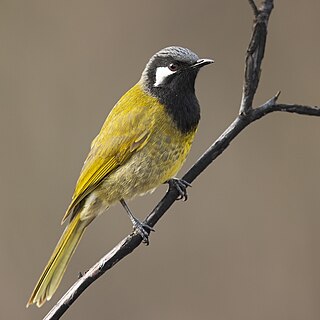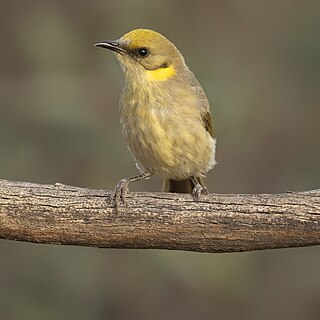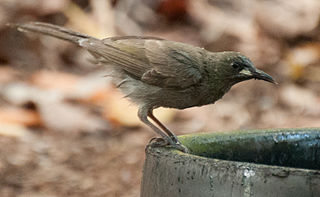
The yellow-faced honeyeater is a small to medium-sized bird in the honeyeater family, Meliphagidae. It takes its common and scientific names from the distinctive yellow stripes on the sides of its head. Its loud, clear call often begins twenty or thirty minutes before dawn. It is widespread across eastern and southeastern Australia, in open sclerophyll forests from coastal dunes to high-altitude subalpine areas, and woodlands along creeks and rivers. Comparatively short-billed for a honeyeater, it is thought to have adapted to a diet of flies, spiders, and beetles, as well as nectar and pollen from the flowers of plants, such as Banksia and Grevillea, and soft fruits. It catches insects in flight as well as gleaning them from the foliage of trees and shrubs.

The white-eared honeyeater is a medium-sized honeyeater found in Australia. It is a member of the family Meliphagidae which has 190 recognised species with about half of them found in Australia. This makes them members of the most diverse family of birds in Australia. White-eared honeyeaters are easily identifiable by their olive-green body, black head and white ear-patch.

Lichenostomus is a genus of honeyeaters endemic to Australia.

The singing honeyeater is a small bird found in Australia, and is part of the honeyeater family Meliphagidae. The bird lives in a wide range of shrubland, woodland, and coastal habitat. It is relatively common and is widespread right across Australia west of the Great Dividing Range, through to the west coast and on Western Australian coastal islands. It does not occur in other countries.

The banded honeyeater is a species of honeyeater in the family Meliphagidae with a characteristic narrow black band across its white underparts. It is endemic to tropical northern Australia.

The green-backed honeyeater is a species of bird in the family Meliphagidae. It is monotypic within the genus Glycichaera. It is found in the Aru Islands, New Guinea and northern Cape York Peninsula. Its natural habitat is subtropical or tropical moist lowland forests.

The mangrove honeyeater is a species of bird in the honeyeater family Meliphagidae. The species was once considered to be conspecific with the varied honeyeater, but it is now treated as a separate species. These two species form a genus with the singing honeyeater.

The yellow-tinted honeyeater is a species of bird in the family Meliphagidae. It is found in northern Australia and Papua New Guinea. Its natural habitats are subtropical or tropical moist lowland forests and subtropical or tropical mangrove forests.

The yellow-throated honeyeater is a species of passerine bird in the honeyeater family Meliphagidae. It is similar in behaviour and appearance to the white-eared honeyeater and is endemic to Australia's island state of Tasmania. It was formerly considered a pest of orchards.

The yellow honeyeater is a species of bird in the family Meliphagidae. It is endemic to Australia.

The bridled honeyeater is a species of bird in the family Meliphagidae with distinctive rein-like markings on its face that is endemic to northeastern Queensland. It is found in subtropical or tropical moist upland forests and subtropical or tropical rainforests, usually above 300 meters. In winter, it descends to lower forests including mangroves, and can sometimes be seen in more open habitats.

The fuscous honeyeater is a species of bird in the family Meliphagidae. It is endemic to eastern Australia, where it inhabits subtropical and tropical dry forests.
The Eungella honeyeater is a species of bird in the family Meliphagidae and is endemic to Australia.

The obscure honeyeater is a species of bird in the family Meliphagidae. It is found in New Guinea.

The grey-fronted honeyeater is a species of bird in the family Meliphagidae. It is endemic to Australia. Its natural habitat is Mediterranean-type shrubby vegetation. The grey-fronted honeyeater was originally described in 1841 by English ornithologist John Gould as Lichenostomus plumulus. It was moved to the genus Ptilotula after a molecular phylogenetic analysis, published in 2011, showed that Lichenostomus was polyphyletic.

The white-gaped honeyeater is a species of bird in the family Meliphagidae. It is endemic to Australia.

The red-headed myzomela or red-headed honeyeater is a passerine bird of the honeyeater family Meliphagidae found in Australia, Indonesia, and Papua New Guinea. It was described by John Gould in 1840. Two subspecies are recognised, with the nominate race M. e. erythrocephala distributed around the tropical coastline of Australia, and M. e. infuscata in New Guinea. Though widely distributed, the species is not abundant within this range. While the IUCN lists the Australian population of M. e. infuscata as being near threatened, as a whole the widespread range means that its conservation is of least concern.

Ptilotula is a genus of honeyeater consisting of species occurring in Australia and Papua New Guinea. The genus consists of six former members of Lichenostomus, and was created after a molecular analysis showed the genus was polyphyletic. The International Ornithologists' Union accepted this change and officially included the genus in reference lists from 2013. The type species is the yellow-tinted honeyeater. Birds in this genus typically occupy dry open forest and woodland habitats, and can be found in arid and semi-arid environments.

Gavicalis is a genus of honeyeaters endemic to New Guinea and Australia. It contains former members of Lichenostomus, and was created after a molecular phylogenetic analysis published in 2011 showed that the original genus was polyphyletic.



















